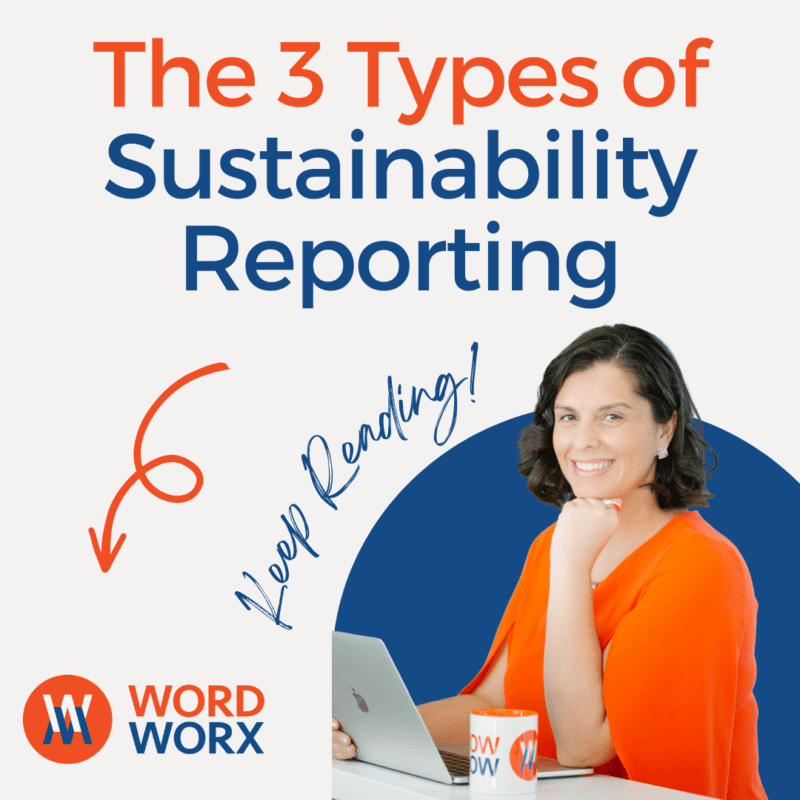Get to know the three types of sustainability reporting!
Years ago, when I was approached to write my first-ever standalone sustainability report, I thought that only such documents existed when it came to reporting on sustainability topics. However, I quickly learned that there are, in fact, various ways in which a company can report on sustainability goals, achievements, and highlights:
- Integrated reports
- Annual reports
- Sustainability reports

Choosing the right approach or combination of approaches depends on the company’s goals, stakeholder expectations, and the desire to convey a comprehensive picture of sustainability efforts.
And as reporting on ESG matters becomes increasingly important, it’s fundamental to know the differences between the abovementioned three types of reporting to determine which type may be best suited to your company.
Below, I outline these three types of sustainability reporting, the key features of each, and the differences in approaches.
1. Integrated Reports
Integrated reporting is a particularly holistic approach to sustainability that goes beyond just financial data. Such reports attempt to provide a comprehensive overview of a company’s performance, including its financial, environmental, social, and governance aspects. The primary goal of integrated reporting is to show how these different aspects are interconnected and contribute to the company’s long-term success.
Key features of Integrated Reports
- Comprehensive — Integrated reports provide stakeholders with the bigger picture —a 360-degree view — of a company’s sustainability performance. This is a bit like a bird’s eye view of reporting.
- Connected — It highlights the connections between financial performance and ESG factors, demonstrating how sustainability efforts can impact a company’s bottom line. This approach differs significantly from standalone sustainability reports, which typically do not include financial data.
- Stakeholder Engagement — Integrated reports often emphasise the importance of engaging with stakeholders and responding to their concerns, fostering transparency and trust.
2. Annual Reports
Annual reports are the second of the three types of sustainability reporting, and they have long been part of corporate communication activities, primarily focused on financial performance. However, in more recent years, many companies have started to incorporate sustainability information into their annual reports in a separate sustainability section within the report. This integration recognises that sustainability is a fundamental aspect of a company’s overall performance and should be reflected in its annual disclosures.
Key Features of Annual Reports with Sustainability Section
- Financial and Non-Financial Data — Annual reports with a sustainability focus include both financial data, such as revenue and profit figures, and non-financial data, such as carbon emissions, diversity statistics, and social impact metrics.
- Compliance and Regulation — Annual reports with a sustainability focus also often align with regulatory requirements and industry standards for reporting, ensuring transparency and consistency.
- Stakeholder Awareness — Incorporating sustainability information into annual reports helps raise increased awareness among shareholders and investors about a company’s commitment to ESG principles.
3. Sustainability Reports
The last of the three types of sustainability reporting is a sustainability report. These reports are also known as CSR (Corporate Social Responsibility) reports or ESG reports and are dedicated, standalone documents that comprehensively detail a company’s performance when it comes to sustainability. These reports are specifically designed to provide stakeholders with in-depth insights into the company’s ESG practices, initiatives, and progress toward sustainability goals. They generally do not include financial information related to sustainability or how sustainability activities impact the company’s bottom line.
Key features
- Particularly focused on Sustainability — Standalone reports place a spotlight on environmental, social, and governance factors, making them the go-to resource for stakeholders interested in a company’s sustainability efforts. They have huge branding and marketing benefits as well as corporate communication advantages as they can be aligned with campaigns on sustainability, for example.
- Goal Tracking — These reports often include a breakdown of sustainability goals and the company’s progress in achieving them, demonstrating a commitment to continuous improvement.
- Transparency and Accountability — Sustainability reports are typically highly transparent, showcasing both successes and challenges and are a way for companies to be held accountable for their sustainability commitments.
That’s a Wrap for the Three Types of Sustainability Reporting
As you can see, each approach has a different focus with key characteristics. Regardless of the method you opt for, the importance of reporting on sustainability cannot be understated. And the benefits are immense for our world, our people, and the way in which we do business.
Should you require support in your upcoming sustainability report, feel free to contact me.